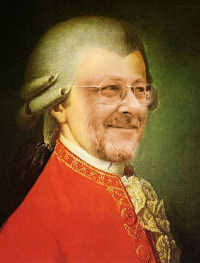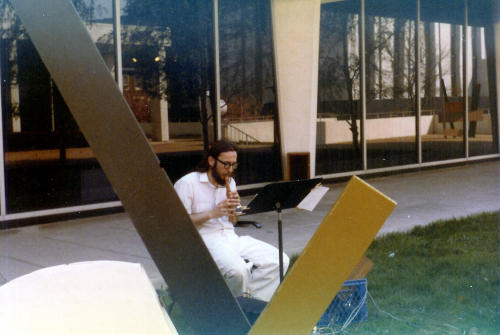A 365-Day Project
"We Are All Mozart"
A project to create
new works and change
the perception of the
music of our time.


 October 14, 2006
October 14, 2006 
Today was occupied doing one of my least favorite tasks: score cleanup. January is the Chamber Music America convention in New York, and it will be my first appearance at that sort of professional event. As an independent -- read 'mongrel' -- composer, I'm loaded up with a career's worth of chamber music, some of it pretty good. The mongrel part means there's also a bucket or two of electroacoustic music, a good few dozen pieces of performance art and a some full-scale sound installations, too. And a dozen symphonic tunes. I don't fit well in the chamber music suit, even if I write it.
Anyway, these chamber tunes have gotta look good and sound good. But moving on is my theme. It's not that the older pieces are bad -- omigawd, like, whoa, some are scary ugly -- but who can reinhabit their old homes, old clothes, old lives? Going back to elementary school, one sees how small it is. What seemed fearsome is ordinary, what seemed fascinating is familiar. Old homes ... did I really live there? And the overwhelmingly silent and exquisite nodding adolescent agreement with the final lines of La Symphonie Pastorale, "J'aurais voulu pleurer, mais je sentais mon coeur plus aride que le désert." Ah, Gide, mon sembable! Mon frère!
But no, it isn't there, is it? And however much that Exequy felt note- and sensibility-perfect on the day it was completed by an exhaused twenty-two-year-old, it slipped quickly away, objectified itself, and became A Composition, some music that I once wrote. With longer pieces, interest in the beginning has faded before the end is reached. It's that foreknowledge that drives me to work straight through on compositions, figuring them out and writing them down wholesale.
The reason for this approach has been recounted: two years of commuting by bus to college, two hours each way, with no chance to 'test' what was on the paper -- including a twelve-minute electroacoustic composition that was graphically scored six years before it could be realized to tape and sixteen years before it was publicly premiered. By 1971, the creative process had become a sequence of imagine, coalesce, empty, and forget. It's a practice that hones skills and simultaneously crushes patience, with every note or gesture or transformation having to be valuable enough to remember. It's also a practice that creates a sense of dismissiveness, that is, whatever did not contribute to the creative path was derogated. For example, traditional harmony has never felt important. Every expectation that has ever been harmonically created has had three centuries to be fulfilled, deceived or denied, right down to the ol' I-iii in Puff, the Magic Dragon. (At least there's Gesualdo for long, dull winter days of dotage.)
Going back over earlier scores also produces a wistful (I almost wrote winsome) feeling of erratic madness of a bunny-slope beginner on the black diamond trail. Pieces of me are splattered everywhere. No consistent ensembles exist. Where are the string quartets and piano trios and wind quintets? Does a graphical string quartet count? One piano trio? How about a horn octet? Theremin and piano? Three pianos? Flute, bass clarinet and playback? Baritone sax and percussion? Euphonium and playback? Drumkit and playback? Lots of those playback pieces exist, what used to be called tape. Violin and cello, not bad. The Quartet for the End of Time orchestration (with all the strings good), I've got a few of those because that's the core of the Vermont Contemporary Music Ensemble. Flute, cello, piano, percussion; nine strings; violin, cello, two bass clarinets, and percussion; alto sax, bassoon and piano; English horn and string quartet; two oboes, English horn, alto clarinet and trombone; two violins; violin, clarinet, marimba, diskklang, forkklang, and harmonic voice; tuba and playback; twelve players of any instrument (that's good, isn't it? not necessarily if the score includes an imaginary star chart); viola and contrabass; violin, two celli, and harpsichord; horn and bass clarinet; tuba quintet... yes, that's the idea. Writing for whatever comes available is hardly a way to become known for one's legendary proficiency in a genre.
Even listing those pieces invited my head to drop onto the keyboard, hard. Who else is going to play something for violin, clarinet, marimba, and two organs, other than those who asked for it? It's a fine piece Build, Make, Do is, but in five years it's never been downloaded.
As I check for the clarity and attractiveness of the Build, Make, Do score, though, I wonder what drives composers to fiddle with their scores, revising music they've written years before. Is there really a way to recover one's state of mind? Is the revision a rethinking? If it is, the performer is put in the awkward position of having to accept a schizophrenic view of a composition.
Yet occasionally one does uncover more in a composition than was well explicated the first time around. It suggests more. A composer whom I consider a mentor once told me how much he disliked one of my pieces because it did not fulfill what it promised, and I since became sensitive to the natural form of the idea, much as sculptors look for idea direction and completion within the wood or the marble. For example, I taught at the Vermont Governor's Institute for the Arts where, during the final day's farewell party, students brought around journals for each of us to write in. My comment to one student was a brief, evocative flute composition -- written as the thump & scream of a rock band filled the room. The memory of the piece stayed with me (not the piece itself, which faded as they all do) and some years later the student sent me a copy, which I then copied out and titled Noma. But that brief composition had more to say, as became obvious when it was played so beautifully by Ned McGowan in 2003. And so on the death of my wife's father in 2005, the music ran itself out into a long arch of sound, becoming Shahmat, fulfilling its promise.
Such surprises are rare. A composition is a sonic time machine -- however much it startles and engages a first-time listener or performer, or even intrigues the composer who becomes reacquainted with its magic, it speaks only from its moment of creation. (The adulation of ancient composers is built upon the concept of art speaking to & through the ages -- patent nonsense. Art is time in a bottle.)
And so I enjoy a moment of admiration for a younger composer, bring back a few memories, have a few laughs, slap the forehead a good number of times at opportunities not pursued, and push on to the next. Oh -- I hear the question hanging in the air. "If you don't care, why should anyone else?" Ouch. It's an excellent question, exposing a hubris-driven hypocrisy that maybe, just maybe, my tunes are worth plucking from the past to the present. And I'm not dead yet. That was a clever bit of verbal sleaze, no? Okay, a more serious answer: Some I like. Some have never had a good performance, complete performance, or any performance at all, and I'd like to have one for personal pleasure. And finally, there are many pieces that, despite their date, did not have an audience yet ready for them. Oh, the arrogance. But no -- it's true of most composers who have a few experimental bones on which to hang their skin. Because of circumstances of the nonpop art, there still exists a temporal chasm between composer and listener. That my 1972 Construction "on nix rest... in china" was not hawked at some convention but rather chosen for performance from my online catalog a full thirty-one years after it was composed confirms that for me. On the other hand, many works are true period pieces which, despite their intensity and occasional brilliant shine, have no business being heard again. (Their continued existence is testament only to my compulsiveness.)
So, onward. As Stevie says, it's about love and adventure, and I believe her.

Time capsule photograph: A performance of Somnambula, New Jersey State Museum, 1977.